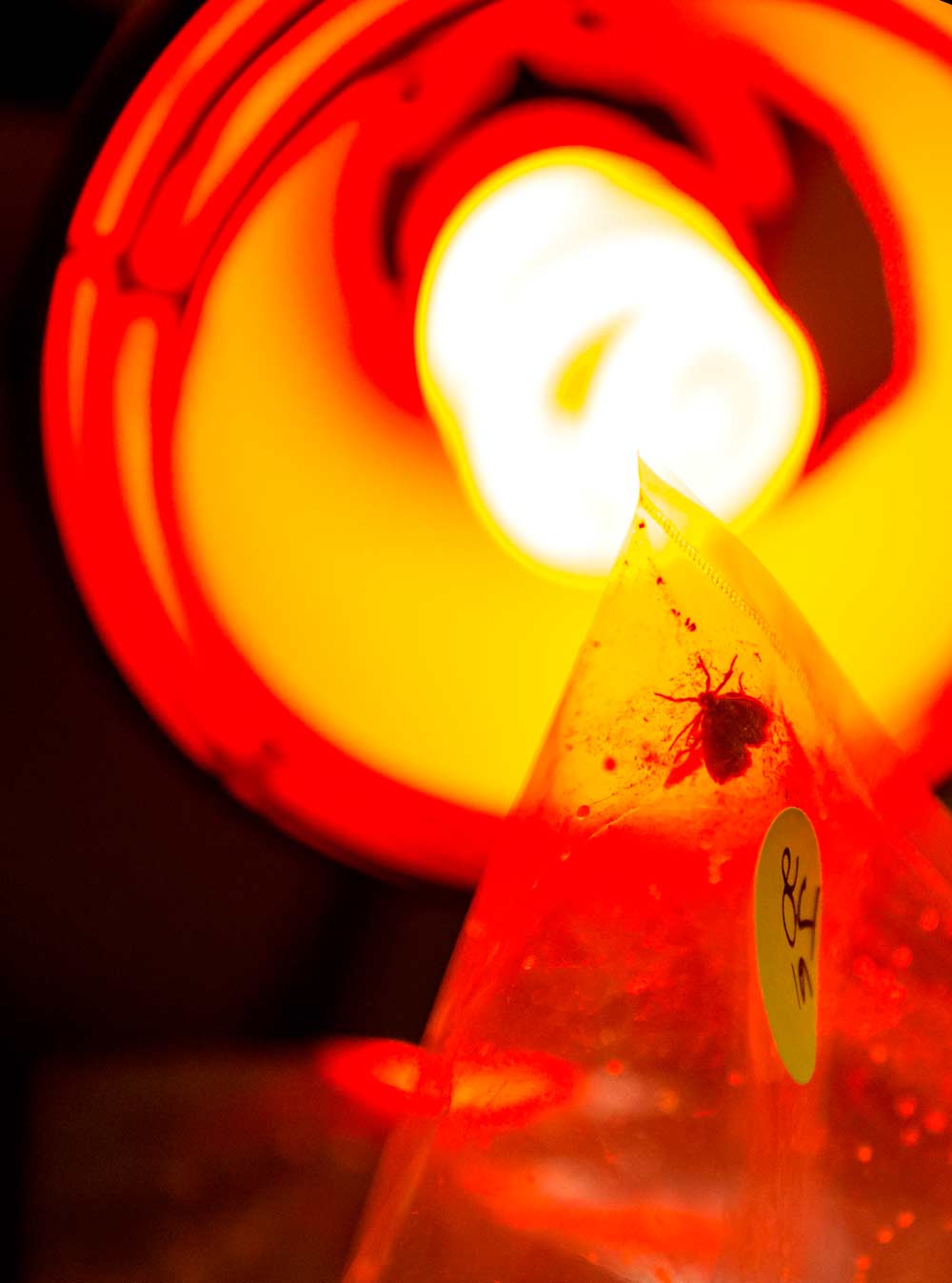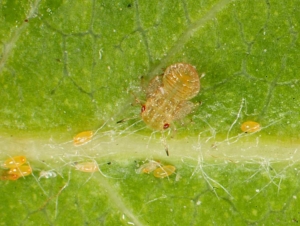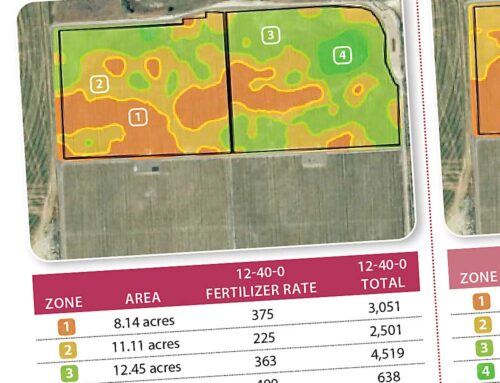
Steve Garczynski maintains several codling moth broods at the USDA ARS facility’s codling moth warm eclosion (QC) room where the insects are tightly managed to produce a consistent egg laying schedule for their CRISPR program. (TJ Mullinax/Good Fruit Grower)
Scientists at the U.S. Department of Agriculture’s Agricultural Research Service in Wapato, Washington, conduct research on insect pests of tree fruits and potatoes.
The tree fruit research group employs eight entomologists — two with split appointments between tree fruit and potatoes — having expertise in molecular biology, chemical ecology, insect physiology/behavior, insect ecology, biocontrol and integrated pest management.
These entomologists work closely with other entomologists at Washington State University and collaborate with scientists from around the world.
Our research takes a multi-pronged approach to improve knowledge of the biology/ecology of insect pests and to develop novel biorational approaches for their management.
Here is an update on a few of our projects:
Insect Physiology
The research interests of Lisa Neven, Ph.D., (Lisa.Neven@ars.usda.gov) lie in the areas of invasive species, regulatory entomology, quarantine treatments and predictive modeling to prevent the spread of pests of tree fruits.
Neven has developed several organically compliant quarantine treatments for apples, pears, cherries, peaches and nectarines.
In recent years, she has been involved in developing ecological niche models to predict those areas most at risk of establishment and spread of invasive tree fruit pests both within the U.S. and throughout the world. Her area of expertise is in physiological ecology, with an emphasis on the effects of environmental stress on insect physiology.
Management of Fruit Flies

Cherry fruit fly. (Courtesy Mike Bush)
Wee Yee, Ph.D., (Wee.Yee@ars.usda.gov) focuses on the ecology and management of western cherry fruit fly and apple maggot fly, two quarantine pests of cherries and apples, respectively, in the Pacific Northwest.
Work on cherry fruit fly includes development of more sensitive systems for detecting different fly stages at pre- and postharvest, gathering data to predict suitable fly habitats, and studies to determine most efficacious approaches to insecticide management of flies.
Work on apple maggot fly includes determining ways to prevent movement of flies from quarantine to pest-free areas, susceptibility of different apple cultivars to fly attack, development of more effective trapping systems, and management of habitats to reduce or eliminate fly populations.
The ultimate goal of the research is to reduce risks of flies hindering domestic and international movement of fruit.
Insect Genetics
Research in the lab of Steve Garczynski, Ph.D., (Steve.Garczynski@ars.usda.gov) focuses on understanding, at the molecular level, how the codling moth uses its sense of smell to detect odors, allowing males to find female mates and females to find egg-laying sites in apple.
Garczynski, along with collaborators at the Swedish University of Agricultural Sciences, has identified key proteins that detect pheromones (i.e., codlemone) and plant-produced volatiles (i.e., pear ester).
To identify which proteins can be exploited for insect control, the Garczynski lab has developed, and successfully used, CRISPR/Cas9 genome editing in codling moth. Using the CRISPR/Cas9 system, future research will focus on determining which proteins are vital for codling moth survival and how to use this knowledge to enhance codling moth control in the orchard.
Attract-and-Kill for Management of Tortricid moths
The research of Alan Knight, Ph.D., (Alan.Knight@ars.usda.gov) centers on refining the use of sex pheromones and plant volatiles for Washington growers’ use in monitoring and management.
A new attractant with potential for improved monitoring and mass trapping was discovered for codling moth, and collaborative tests are underway throughout South America. Fortunately, a new, more sensitive lure has been developed to monitor both sexes of the oriental fruit moth.
Two plant attractants have been identified for our leafroller pests and these can monitor both sexes in pheromone-disrupted orchards and to develop mass trapping. Development studies continue with a new sprayable sex pheromone formulation and a refinement of Meso dispensers used at 20-32 per acre for codling moth.
Biology and Management of Pear Psylla

Pear psylla early instar nymph with eggs. (Courtesy Betsy Beers, WSU)
David Horton, Ph.D., (David.Horton@ars.usda.gov) has spent his 20-plus year career with ARS conducting research on pear psylla, with primary interests in psylla diapause and dispersal, mating activity and biological control.
His current work evaluates whether the acoustic signals produced by female psylla and used by males to locate females can be synthesized and then disseminated through pear orchards to slow mating of psylla.
These studies are being done in collaboration with Betsy Beers and David Crowder of Washington State University with funding from the pear industry.
Horton and Cooper are also collaborating with an ARS entomologist at the Fort Pierce, Florida, laboratory in testing whether certain compounds discovered to stimulate feeding by citrus psyllid prompt the same responses in pear psylla.
Studies in Florida are showing that adding the compounds and a toxicant to a sprayable bait matrix can lead to attract-and-kill effects on citrus psyllid.
Rodney Cooper, Ph.D., (Rodney.Cooper@ars.usda.gov) conducts research on biology and ecology of pear psylla, with an emphasis in plant defenses, bacterial endosymbionts and overwintering ecology. Cooper and Horton are working on molecular gut content analysis to track the landscape-wide migrations and shelter plant use by overwintering psylla with funding from the pear industry.
Vacant positions in chemical ecology and biological control
Two positions are currently open due to recent retirements, including a position in biological control previously filled by Thomas Unruh, Ph.D., and a position in chemical ecology previously filled by Peter Landolt, Ph.D.
Landolt’s recent research included developing lures for mass trapping of codling moth, a regional survey of native and invasive stink bugs including brown marmorated stink bug, and developing monitoring tools for Polistes wasps, which pose hazards to orchard workers.
Unruh’s research focused on biological control of tree fruit pests including aphids, pear psylla and leafrollers. These essential positions in chemical ecology and biocontrol will likely be filled in the near future.
In addition, two postdoctoral entomologists, Tewodros Wakie, Ph.D., and Gene Miliczky, Ph.D., and 12 biological science technicians make up the tree fruit research group. •
By W. Rodney Cooper, Stephen Garczynski, David Horton, Alan Knight, Lisa Neven and Wee Yee
The writers are researchers at the U.S. Department of Agriculture’s Agricultural Research Service in Wapato, Washington. For more information on entomological research at the USDA-ARS in Wapato, contact the research leader, Lisa Neven, at Lisa.Neven@ars.usda.gov.






It is great to learn about USDA-ARS lab’s research in Washington, and how it is contributing to the scientific management of insect pests of tree fruits and helping the industry.
Keep up your great work. All the best.
We combat all of this by breaking H2o into 13 molecules while increasing yield, reducing water consumption as much as 50% and fertilizer’s almost as much. We also provide a much longer shelf life.